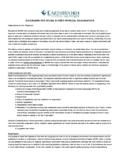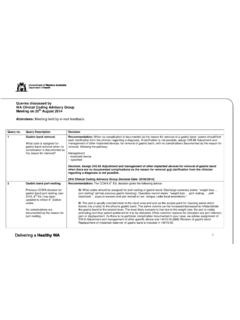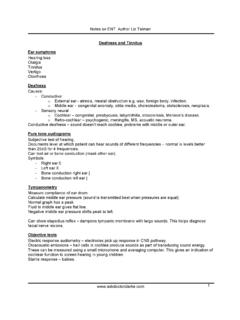Transcription of Tympanometry - Paedatric ENT Services
1 TympanometryWhat is Tympanometry ? Tympanometry is a technique used to look at the function of the middle ear. It is NOT a hearing test. It is a test used together with otoscopy (looking into the ears) and audiometry (testing the hearing) and is useful in helping to determine how the middle ear is functioning. How does a tympanometer work?The procedure of Tympanometry involves inserting a probe into the outer ear canal and creating an air-tight seal. The probe contains a tiny speaker, a microphone and an air pump. The air pump changes the air pressure range (typically +200 daPa to 400 daPa) in the ear canal. The speaker introduces a calibrated tone into the ear canal, which changes in frequency and loudness. Some of the sound produced by the speaker will be passed through the middle ear, while some of the sound will be reflected back off of the tympanic membrane.
2 The microphone measures the amount of reflected sound in the ear canal. The compliance of the eardrum and middle ear ( how well this system responds to sound) is then determined by the tympanometer as the air pressure changes. What is a tympanogram?A tympanogram is a chart which can tell us how well the middle ear is does a tympanogram tell us?Tympanograms are classified into types according to the shape of the tympanometric trace ( peak ), which is dependent upon the middle ear pressure, and the middle ear tympanogram can provide three helpful pieces of information: Middle ear pressureThis is the air pressure of the air contained within the middle ear. It is shown by where the peak of the tympanometric trace falls along the pressure ear pressure values ranging from +50 daPa to 200 daPa for children, and +50 daPa to 50 daPa for adults is generally considered compliance of the middle ear system is a measure of how well the system responds to sound.
3 This is shown by the height of the peak .Middle ear compliance values from to cc are usually considered volume of the ear canalNormative ear canal volumes vary as a function of age. Typically for children a volume range of to cc is typically considered normal, while for adults the range is to cc. This value is reported by the tympanometer, but not shown on the tympanogram general, classification of tympanograms is as follows:Type A tympanograms normal middle ear pressure Peak between +50 daPa to 200 daPa for childrenType C tympanograms abnormally low middle ear pressurePeak less than 200daPa for childrenType B tympanograms no pressure peakCompliance values and equivalent ear volume allow classification into subtypes, and provide valuable information for standard Type A tympanogram, with normal middle ear pressure (Pres = -25) and normal compliance (Comp = ), is indicative of a properly functioning Eustachian tube.
4 Generally this tympanogram would be described as representing normal middle ear As tympanograms, with normal middle ear pressure (Pres = -20) but reduced compliance (Comp = ) can represent normal middle ear function, or a stiff middle ear system suggestive of some form of ossicular fixation (otosclerosis or tympanosclerosis affecting the ossicles) with normal Eustachian tube Ad tympanograms, with normal middle ear pressure (Pres = -15) but increased compliance (Comp = ) indicate a flaccid, or hyper-mobile, middle ear system. This could represent an ossicular subluxation (a partial or full ossicular discontinuity), or a healed tympanic membrane A:There are three sub-types of Type A tympanograms, A, As and Ad. All Type A tympanograms have normal middle ear pressure peaks. Following are illustrations of the Type A sub-types:A Type B tympanogram with normal ear canal volume (ECV = cc) typically means a middle ear effusion.
5 However, some people with very thickened tympanic membranes, or perforations may also exhibit a tympanogram of this B tympanogram with a high ear canal volume (ECV = ), consistent with a tympanic membrane perforation, a patent grommet or T B tympanogram with a low ear canal volume (ECV = ) indicating that the probe is blocked, either by wax in the ear canal, or the probe tip is against the side of the ear canal B:Type B tympanograms exhibit no air pressure peaks and are generally described as flat tympanograms. There are several middle ear conditions, which can result in Type B tympanograms. Type B subtypes are those with normal equivalent ear canal volume those with high equivalent ear canal volume those with low equivalent ear canal volume. This Type C tympanogram, with normal compliance (Comp = ) but low middle ear pressure (Pres = -275) typically means a Eustachian tube dysfunction without the presence of middle ear effusion.
6 This Type Cs tympanogram, with reduced compliance (Comp = ) and low middle ear pressure (Pres = -330), in addition to indicating a Eustachian tube dysfunction, most likely also means there is some fluid in the middle ear as well as some Type Cd tympanogram, with increased compliance (Comp = ) and low middle ear pressure (Pres = -240), also suggests either an ossicular subluxation, or healed tympanic membrane perforation (similar to Type Ad) with Eustachian tube C:Type C tympanograms generally have similar compliance values and shapes as Type A tympanograms. What sets them aside from Type A tympanograms is that the middle ear pressure is abnormally low indicating Eustachian tube dysfunction.







